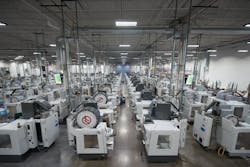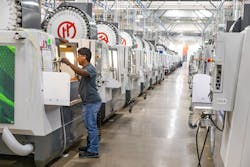5 Common Machining Mistakes to Avoid
Design best practices are highly technology dependent and CNC machining is no exception. As a subtractive manufacturing process, machining comes with a specific subset of design dos and don’ts. Here are five frequent design mishaps we often see at Protolabs as we work with customers to address design-for-manufacturing of machined parts.
1. Adding Tall, Thin Walls
Parts with walls—generally—don’t tend to work well as they’re prone to rippling, bending, chipping or breaking during the cutting process. Taller walls will likely require added thickness for support. Protolabs recommends walls with a width-to-height ratio of 3:1. Adding draft (a slight angled taper) to a wall is one way to sidestep potential issues.
2. Small, Intricate or Raised Text
It’s common for parts to require a serial or identification number of some kind. Keep in mind that adding text to parts means added cost. While one might equate smaller to less expensive, it’s the opposite in this case. Small endmills that cut the text run at a markedly slower speed and add more time on parts, meaning increased cost. Larger text is a faster process to achieve and recessed text versus raised, is much more cost efficient.
3. Out-of-Pocket Features
Adding square corners or internal small corner pockets are common design tweaks attempting to cut down on part weight, but the small tools required to machine these features add substantial overall cost. Protolabs recommends thinking through how critical the pockets are to the part. If they’re intended only to reduce weight, consider other ways to achieve that in the design.
4. Incorporating “Non-Threadable” Holes
Adding threaded holes to a part is easy if hole diameters are confirmed within the range for the static set of threads available. As a digital manufacturer, quoting software allows users to choose the thread and then automatically identifies holes that are in the specific diameter range for the selected thread. This Threaded Hole Guidelines page lists available threads. Click on a particular one to show a range of acceptable hole diameters to choose.
READ MORE: How Design for Excellence (DfX) Intersects with Rapid Prototyping
5. Moving from Machining to Molding
Each manufacturing process has unique design requirements. Protolabs often sees molded parts uploaded to its machining services for prototyping prior to purchasing a mold. For example, a molded part may include ribs and pockets, which works well for molding; however, these features add significant run time for machining. All in all, ensure that part design is optimized for its intended manufacturing process.
Taking a bit of extra time in the design phase to ensure optimal machinability can save significant time and overall cost. After uploading a 3D CAD model, work with applications engineers to ensure that design is ready to run smoothly.
Dan Snetselaar is a CNC product leader at Protolabs.
About the Author

Dan Snetselaar
CNC Product Leader, Protolabs
Dan Snetselaar is CNC machining product leader at Protolabs. He has been with Protolabs for almost a decade, initially joining the additive manufacturing team. Through that, he was introduced to the company’s service lineup and CNC machining was expanding. With his father being an engineer and a builder, Snetselaar has always gravitated towards Protolabs’ technical aspects, specifically the automated machining process. He started as a business development representative, then a technical skills training leader, which was the catalyst to become a subject matter expert in machining.

